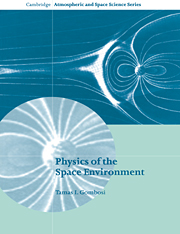Chapter 9 - Airglow and Aurora
Published online by Cambridge University Press: 22 October 2009
Summary
Humanity has always been fascinated by atmospheric sources of light. The first records of auroras date back thousands of years to biblical, Greek, and Chinese documents. The name aurora borealis (latin for northern dawn) was coined by the French mathematician and astronomer, P. Gassendi, who described a spectacular event observed in southern France on September 12, 1621. Airglow was discovered in 1901 by Newcomb who explained it as light from stars too faint to be seen individually. It was not before the 1930s that scientists realized that the source of the faint “light of the night sky” must be zodiacal light and atmospheric luminescence. Figure 9.1 shows a photograph of a spectacular aurora.
Both aurora and airglow are caused by excitation of atmospheric species followed by subsequent radiation of photons. They are, however, quite different in terms of excitation mechanisms, temporal and spatial characteristics, intensity, and dominant emissions.
Airglow is the amorphous, faint optical radiation continuously emitted in wavelengths from the far UV to near infrared (but excluding thermal emissions in the long wavelength infrared). The Earth's airglow mainly originates from discrete atomic and molecular transitions (an exception is a weak continuum in the green). Airglow is mainly caused by three fundamental processes: direct scattering of sunlight, emissions associated with ionization and recombination, and radiation associated with neutral photochemistry.
- Type
- Chapter
- Information
- Physics of the Space Environment , pp. 158 - 175Publisher: Cambridge University PressPrint publication year: 1998

